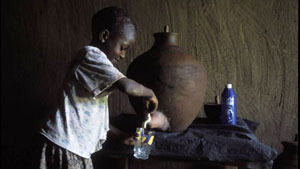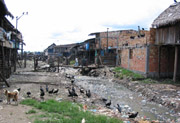For Specific Groups
Publications, Data, & Statistics
Global WASH Resources
Healthy Water Sites
- Drinking Water
- Healthy Swimming/Recreational Water
- Global Water, Sanitation, & Hygiene (WASH)
- Other Uses of Water
- Water-related Emergencies & Outbreaks
- Water-related Hygiene

Global access to safe water, adequate sanitation, and proper hygiene education can reduce illness and death from disease, leading to improved health, poverty reduction, and socio-economic development. However, many countries are challenged to provide these basic necessities to their populations, leaving people at risk for water, sanitation, and hygiene (WASH)-related diseases. CDC programs such as the Safe Water System can empower communities to improve their water by using household treatment options.
Global Water, Sanitation, and Hygiene Topics
Community Systems
Water Safety Plans, Assessment and Development...
Sanitation & Hygiene
Toilets & Latrines, Hygiene, Sewer & Wastewater...
Household Water Treatment
Safe Water System, Safe Storage...
Travelers' Health
Safe Drinking & Recreational Water, Injury & Illness...
Global Water Fast Facts
- Water, sanitation and hygiene has the potential to prevent at least 9.1% of the global disease burden and 6.3% of all deaths 1.
- Worldwide, 780 million people do not have access to an improved water source 2. Many more obtain their drinking water from improved, but microbiologically unsafe, sources.
- An estimated 2.5 billion people — half of the developing world — lack access to adequate sanitation (more than 35% of the world’s population) 2, 3.
Global WASH Health Burden

Water is considered to be the most important resource for sustaining ecosystems, which provide life-supporting services for people, animals, and plants. Because contaminated water is a major cause of illness and death, water quality is a determining factor in human poverty, education, and economic opportunities.
Unfortunately, worldwide water quality is declining, threatening the health of ecosystems and humans worldwide. Various factors influence this deterioration, including population growth, rapid urbanization, land use, industrial discharge of chemicals, and factors resulting from climate change.
* An improved water source is defined as water that is supplied through a household connection, public standpipe, borehole well, protected dug well, protected spring, or rainwater collection.
- Prüss-Üstün A., Bos, R., Gore, F. & Bartram, J. 2008. Safer water, better health: costs, benefits and sustainability of interventions to protect and promote health. World Health Organization, Geneva. [PDF- 60 pages]
- World Health Organization and UNICEF. Progress on Drinking Water and Sanitation: 2012 Update. United States: WHO/UNICEF Joint Monitoring Programme for Water Supply and Sanitation; 2012.
- U.S. Census Bureau. International Programs Center: Population Clocks.
Get email updates
To receive email updates about this page, enter your email address:
Contact Us:
- Centers for Disease Control and Prevention
1600 Clifton Rd
Atlanta, GA 30333 - 800-CDC-INFO
(800-232-4636)
TTY: (888) 232-6348 - New Hours of Operation
8am-8pm ET/Monday-Friday
Closed Holidays - cdcinfo@cdc.gov





